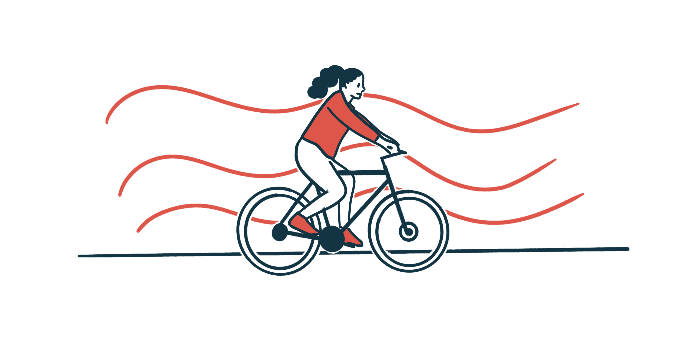AAN 2024: Patients, care partners see improved health with cycling
Participants cycled indoors 2 times a week using a VR platform

Cycling indoors on a stationary bicycle for two may improve the health and well-being of people with Parkinson’s disease and their care partners, a preliminary small study at the University of South Carolina suggests.
The results were presented at the annual meeting of the American Academy of Neurology, which took place April 13-18, in Denver and online, in a poster titled “Functional and Cognitive Benefits of a Community Tandem Cycling Exercise Intervention on Patients with Parkinson’s Disease and their Care Partners.”
“Our study found that a unique cycling program that pairs people with Parkinson’s disease with their care partners can improve the physical, emotional, and mental well-being of both cyclists to improve their quality of life,” Jennifer Trilk, PhD, University of South Carolina School of Medicine, and last author of the study, said in a press release.
Parkinson’s disease is caused by the progressive dysfunction and death of dopaminergic neurons, the nerve cells in the brain responsible for producing dopamine, a signaling molecule important for motor control. Their loss leads to the disease’s symptoms.
Physical exercise, including aerobic exercise programs such as pedaling a stationary bicycle at home, may help ease symptom severity and improve patients’ quality of life, research shows.
Improved health for two — with tandem bicycling
Here, researchers investigated the feasibility and effects of a tandem cycling program on 10 Parkinson’s patient and care partner pairs who cycled indoors on stationary bicycles for two while using a virtual reality platform twice weekly for eight weeks under the supervision of a certified cycling trainer. As part of the program, the cycling time and intensity progressed from 15 minutes to 60 minutes per session.
The participants could visualize themselves cycling in real life and on scenic outdoor routes on large television screens. Tandem cycling also let care partners adjust the pace, facilitating a higher rate of exercise with increasing health benefits.
Following the program, patients saw an improvement in their overall quality of life, as indicated by a 5-point decrease in the Parkinson’s Disease Questionnaire-39 (PDQ-39), which assesses difficulties across eight dimensions of daily living. Lower scores indicate better quality of life. This effect was significant in the mobility dimension scores, with a decrease of 14 points, suggesting an improvement in mobility.
Patients’ total scores in the Unified Parkinson’s Disease Rating Scale (UPDRS) decreased by 8 points after the program, indicating overall motor symptom severity and disease progression had eased. Patients’ 10-meter walking speeds also improved by 0.27 meters per second, as did the functional gait assessment score — a 3.3 point improvement.
Resiliency was assessed by the Brief Resiliency Scale (BRS), where participants ranked six statements about their perceived ability to avoid or recover from stress, while depression was evaluated using the Geriatric Depression Scale Short Form (GDS-SF).
Patients didn’t show changes in resiliency or depression, but care partners did, suggesting the program may help decrease their burden.
Both patients and caregivers saw a significant improvement in heart rate variability and a more responsive autonomic nervous system, which regulates involuntary processes, like heart rate or breathing.
“It is just as important that care partners also receive care, so that is why we included them as the cycling partner,” Trilk said. “The goal of our small study was to determine if tandem cycling was beneficial. The next step will be to confirm the results with subsequent studies that would include more participants.”
The study was supported by the Prisma Health-Upstate Office of Philanthropy and Partnership, the largest nonprofit health organization in South Carolina.
Note: The Parkinson’s News Today team is providing coverage of the American Academy of Neurology (AAN) 2024 Annual Meeting April 13-18. Go here to see the latest stories from the conference.







